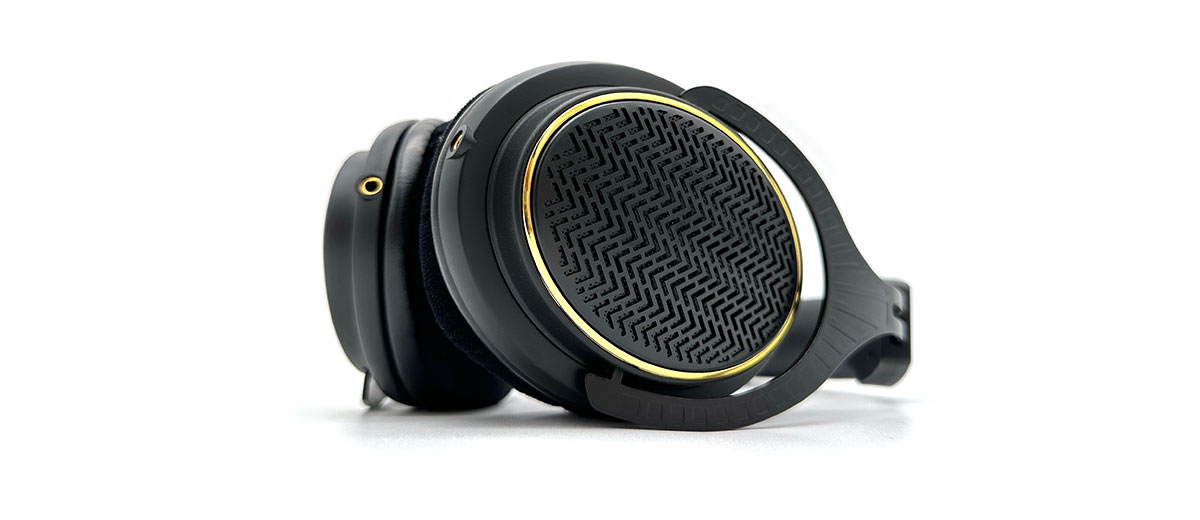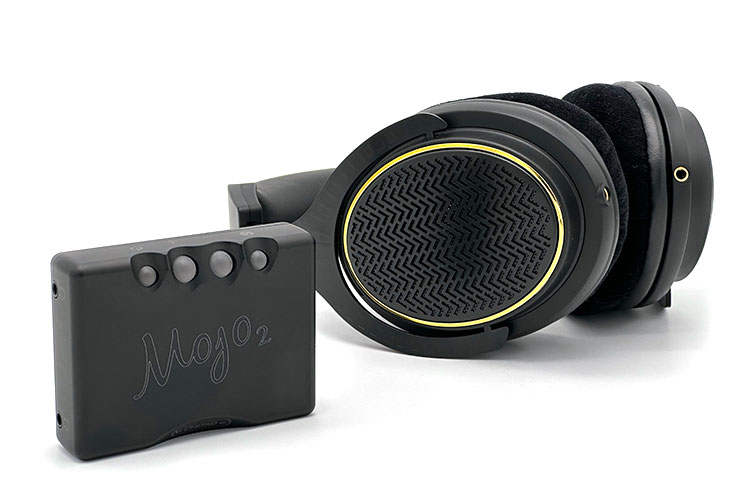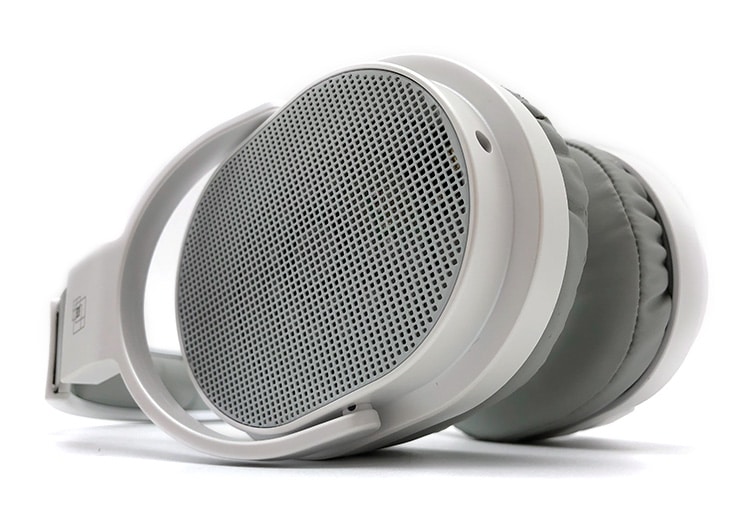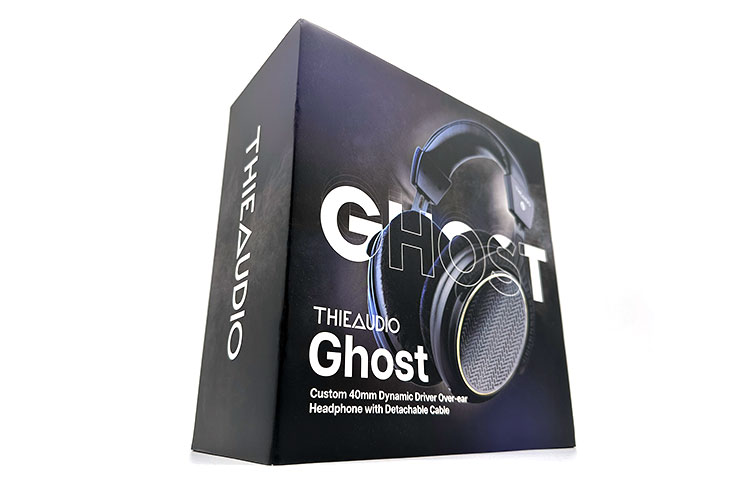Synergy
Efficiency
With a working preconception that the 60Ω Ghost is a portable companion, I let the Chord Electronics Mojo 2 be the impartial judge. With a reasonable 600mW of power on tap, I still found myself pressing the glowing volume orb a little more than expected reaching just over the high gain threshold.
So, while it’s not a power-hungry headphone per se, the fact that the Ghost has a 91dB sensitivity does turn up its power requirement a notch.
I confirmed this with the EarMen ST-Amp which is a beefier desktop amplifier delivering an output of 1.85W to connected cans. The Ghost here wasn’t shy to use up what was available continuously asking me to rotate the amp’s knob up to the 10 to 11 o’clock position for regular listening.
Pairings
The Burson Conductor 3 Reference has taken utmost care to not overdevelop the boisterous side of the Ghost while maintaining the punch and presence of beats.
Dynamics and details, especially in the treble area, are held back but sure enough, It is with bright amplifiers like this one that the behaved upper midrange of the Ghost shows its talent to lower ear fatigue.
Driving the Ghost a few more ways made it clear that it plays well with most sources. Gears like the ST-Amp and Mojo 2 are major candidates for listening pleasure as well.
The ST-Amp made the low-end section push a grander impact tweaking the Ghost to become less dry and boring. Having all these excess energies softens the diffusion causing scenes to not be as exacting.
I like the EarMen DAC/Amp for its talent to allow the Ghost to sing without sounding dull. However, I’m finding that the pairing is not as accurate and spread out in managing imaging and placement for a busy live audience, meshing neighbors easier.
Testing with a more portable solution, the 3.5mm jack of the Ghost is an instant match to the output connections available on the Mojo 2.
Guitars still have a light approach but I’m finding it a touch more refined and naturally voiced. Not as attacking and thin, the Mojo 2 has a feathery sound that slices a scene with care unlike the vividness shown by the C3R with similar instruments.

Select Comparisons
Sennheiser HD560s
$199
Technical
Built with less efficient 120W transducers, the Sennheiser HD560s is another all-new design from Sennheiser that covers a wider frequency range capability than the Ghost at 6Hz-38kHz.
The more extended sub-bass and the optimum triangular listening position from the angled drivers in theory make the HD560s a closer mimic to loudspeaker setups.
Sennheiser doesn’t have ‘cermet’ in their HD560s. Instead, they introduced a new polymer-blend transducer which is geared to improve the reproduction of bass and treble while adhering to a natural and accurate reference sound.
Design
Both are taking an oval shape to follow the natural curvature of the ear and the black suit makes it even harder to differentiate between the two at just a glance. Without prior knowledge, I’d even hand the name ‘Ghost’ to Sennheiser’s creation with its more understated look.
The grills on the Ghost aren’t as outwardly curved as the HD560s. Sennheiser is using softer bends throughout their design that come together into a more unified appearance, if only more dependent on plastic.
At least the plastic extension mechanism on the HD560s has a front-to-rear pivot and a notching action that gives feedback whenever the user is sizing the headphone. Unlike the gliding system on the Ghost, I usually prefer notched ones since they have less chance of becoming loose in the future.
One last thing, both headphones use breathable velour pads that can be replaced when they are worn or to simply change the sound preference. But it is the HD560s that becomes more comfortable since it is roomier thanks to the angled drivers tilting away from the ears and the wider pad opening.
Performance
Anyone who’s heard of the HD560s or even just read its reviews will know that its biggest hook is the stage and reference sound for such a cheap product. While technically more expensive than the Ghost, the clarity gained here is there and is aided by the leaner sonic approach.
If you like deep and enveloping richness to come from drums or bass lines, then the HD560s may be a bit disappointing. Unlike the Ghost, Sennheiser went with tightness and accuracy letting the sub-bass naturally roll off with the mid-bass maintaining a less forward and punchy performance.
Listening back and forth between the two, the HD560s properly connects the subtler parts of vocal dynamics where the Ghost struggles more in aligning the timbre and manifestation. The Ghost in this regard fights back in being the more casual sounding since the HD560s may be airier and lighter but is also shoutier.
For those who like their rock songs served raw then the energetic HD560s will pepper in the texture and detail aside from its lighter tonality. The Ghost will not be as brusque, and in a way feels cushy without getting too withdrawn.
Moondrop Void
$199
Technical
A similarly frontier dynamic headphone like the Ghost, the Moondrop Void is tuned to follow an HRTF frequency target which incorporates the ear as a variable and how it perceives sound from a speaker.
I can’t say for sure if Thieaudio used HRTF as well but note that the Ghost is also designed around the same principle that considers the ear’s pinna.
Using simulation software for designing speaker circuits, the driver for the Void has been crafted to use a metal-coated dome suspended in a flexible suspension system.
The Ghost is dwarfed by 10mm comparing the two’s driver size even though the Void still manages to keep day-to-day usage in mind by staying at an easy-to-use 64W and 110dB efficiency level.
Design
One of the cost-saving measures Moondrop used with the Void is incorporating proprietary molds that spit out whatever design they want in-house effectively cutting the budget for a middleman. I don’t know the limitations of the machine but the Void to me is designed with only the basics, unlike the more sophisticated lines on the Ghost.
The white chassis though is rather light and, in each cup, are separate 3.5mm jacks for balanced listening. With a grid-like pattern on the grills, the Void doesn’t hide its bigger drivers, but the metal grill on the Ghost is still more complex.
The clamp of the Void has a lighter pressure when drawn apart. Its extension mechanism also has notches that can only be felt but not seen on the smooth spring steel that can be pulled out more than the Ghost for bigger heads.
Performance
Joining the Ghost in having a knack for having a little bit of fun, the Void also offers some warmth in the bass region. The difference is in execution, since listening to both, the Void is more mature capturing loose ends on the Ghost into a more cohesive image.
I find that the Ghost is punching a hint harder than the Void. This is one part of the Ghost I like especially when playing loudly. The Void, however, in having a cooler head insists on allowing instruments to sing without covering up important parts.
Taking a slightly opposite vibe, the Void has a sweeter approach to vocals. The Ghost to me sounds more correct since the Void has a bluntness that leaves a note hanging.
Both follow the mantra of not overpowering the spicier regions of a song but the Ghost ultimately loses clarity for having tubbier edges taking away room. The Void here shows why it is a cut higher by being capable of slicing through trickier songs better.
Percussive instruments and horns are more accurate on the Void. The brassy tone and energy of a French horn easily present itself with vigor minimizing the softer qualities of the Ghost.
Our Verdict
The Thieaudio Ghost includes traits that will not alienate budding enthusiasts while sprinkling a healthy proportion of personality making it a unique and interesting set. It won’t be dethroning any higher-priced products but for a casual headphone at $129, the positives outweigh some minor snags.
Matching it with gears many times its price was also a fun one. Without realizing it, I’m a few hours into a session just enjoying the music. And that to me is a sign that the Ghost, given that I am not asking it to squeeze all the details and information out of a song, can be rewarding enough.
It also has a chassis that looks the part. There may be some familiar resemblance with other headphones except the Ghost owns the show by using nice materials for a solid build. Still, adding a swivel and increasing the diameter of the earpads could improve it next time.
Thieaudio Ghost Technical Specifications
- Type: Open-Back headphones
- Drivers: 40mm Sapphire Composite Dynamic Driver
- Impedance: 60W
- Sensitivity: 91dB @1kHz
- Response: 20Hz-20kHz
- Cable Termination: Interchangeable 3.5mm wire
- Headphone Connectors: Dual 3.5mm
- Ear Pads Dimensions: Oval shape with a width of 11cm and a length of 9cm





